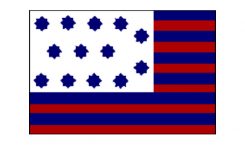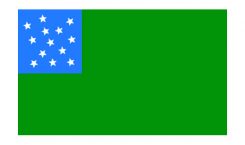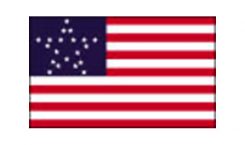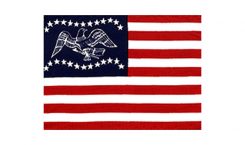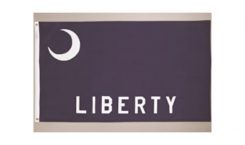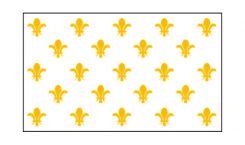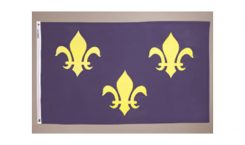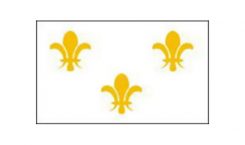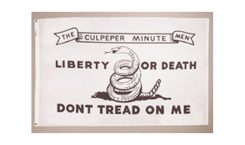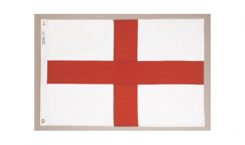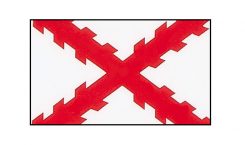No products in the cart.
United States Historical Guilford Courthouse Flag
All outdoor flags have a canvas heading with brass grommets.
This flag is an example of the lack of uniformity in American flags during the Revolutionary period as each group chose what flag to be used as it's standard. This flag has the unique elements of an elongated canton and blue stripes. It was raised over the Guilford Courthouse, North Carolina on March 15, 1781 under the leadership of General Greene whose militiamen halted the British advance through the Carolinas and turned them back to the seaport towns. This was one of the bloodiest battles of the long war with the British losing over a quarter of their troops.
United States Historical Green Mountain Boys Flag
All outdoor flags have a canvas heading with brass grommets.
The Green Mountain Boys were a part of the New Hampshire militia during the Revolutionary War. My (Living History) unit, the 2nd New Hampshire Continental Regiment, fought with the Green Mountain Boys at Hubbardton, where we were all routed or captured. None of us would have gotten away if it had not been for the 'Boys counter-attacking the Hessians.
United States Historical Great Star Flag
All outdoor flags have a canvas heading with brass grommets.
United States Historical General Freemont Flag
All outdoor flags have a canvas heading with brass grommets.
Fort Moultrie Flag
This flag was carried by Colonel William Moultrie's South Carolina Militia on Sullivan Island in Charleston Harbor on June 28, 1776. The British were defeated that day which saved the south from British occupation for another two years. The South Carolina state flag still contains the crescent moon from this Revolutionary flag.
Fleur-De-Lis (White 23) Flag
This flag and design with the coat of arms of France in the center are most commonly associated with ceremonial occasions from 1590 - 1790. There was no specified number of fleurs-de-lis for these flags. Actually this design was printed onto lengths of yard goods and cut off to size as needed.
Fleur-De-Lis (blue) Flag
This royal French flag was used from 1400 until 1590. The most important flag carried by explorers and settlers was most likely the royal flag, since this was a symbol of the authority of the king in the new lands. In the early sixteenth century the French royal flag was blue with three gold fleurs-de-lis representing directly the shield in the royal French coat of arms.
Fleur-De-Lis Flag
Prior to the French Revolution, there was no national flag which represented France. A variety of flags were used by troops, different types of ships and for other purposes. From 1590-1790, this flag is one of four that was used on warships and fortresses. The four flags were; a plain white flag, known as the Bourbon Banner,
Culpeper Flag
This flag represented a group of about one hundred minutemen from Culpeper, Virginia. The group formed part of Colonel Patrick Henry's First Virginia Regiment of 1775. In October-November, 1775, three hundred such minutemen, led by Colonel Stevens, assembled at Culpeper Court House and marched for Williamsburg.
Cross of St. George Flags
This flag was in use during the crusades and it was one of the national emblems of England as early as 1277. In 1497, this flag was flown by John and Sebastian Cabot on their voyages from England to New Foundland and the North American continent, as well as by other English explorers, including Francis Drake, Sir Humphrey Gilbert and Sir Walter Raleigh.
Cross of Burgundy Flag
The Burgundy cross, based on the wooden cross where St. Andrew was crucified, is an old vexillological symbol used by Spain, especially at sea, for many years. In much more recent times, it was used by the Carlists (Requetés) during the Spanish Civil War and afterwards, and by the Traditionalist Party (Partido Tradicionalista) during the post-Franco years.
Cowpens Flag
American hopes were at a low point at the start of 1781. That changed, however, on January 17, when General Daniel Morgan won one of the most brilliant victories of the Revolutionary War at Cowpens, South Carolina. With the help of Maryland, Virginia, and Georgia regiments, Morgan stopped the attacking British dead in their tracks.

